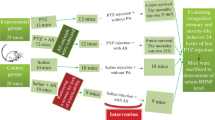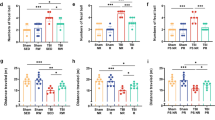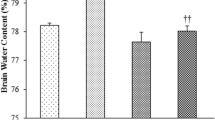Abstract
Purpose
To conduct a systematic review and meta-analysis of studies testing the effect of exercise in Kainic-acid (KA) induced status-epilepticus (SE) and to quantify the efficacy of exercise strategies in the prognosis of SE and co-morbidities.
Methods
Two authors searched online databases (Pubmed and Web of Science) independently for studies testing the efficacy of exercise programs in KA-induced SE models. Reviewers autonomously extracted data on models used, exercise interventions and prognosis in all reported outcomes (behavioral, histological, biochemical and cognitive outcomes). All studies were summarized and relevant outcomes’ data were pooled by means of a meta-analysis.
Results
Among 14 selected studies; Quantitative analysis of studies with pre-SE exercise interventions showed significant reduction in mortality rate among 76 animals of four studies (RR = 0.57, [95% CI 0.34, 0.95], p = 0.03, I2 = 57%) and seizure rating score among three studies (n = 56) with MD = − 1.04, [95% CI − 2.07, − 0.00], p = 0.05, I2 = 71%. Three studies (n = 62) presented with improved anti-oxidant enzymes’ profile (SMD = 0.75, [95% CI 0.55, 2.31], p = 0.0008, I2 = 44%) as a result of exercise intervention. Same intervention failed to show any significant measure for BDNF level and neuroprotection assessed through neuronal number in different brain areas with MD = − 1.22, [95% CI − 136.66, 134.22], p = 0.99, I2 = 0% and SMD = − 0.05, [95% CI − 0.62, 0.52], p = 0.86, I2 = 61% respectively. Qualitative review concluded in the reduction of median seizure score, depression and anxiety-like behaviors with improved cognitive performances in pre-SE exercised animals while improved memory and learning capabilities with increased neurogenesis were observed in post-SE exercised models.
Conclusions
Exercise before SE reduces behavioral seizures and oxidative stress with improvements in cognitive abilities. Post-SE exercise enhances learning and memory with neurogenesis in KA models. More extensive research on morphological and biochemical profiles is needed to explore underlying mechanisms.





Similar content being viewed by others
Abbreviations
- TLE:
-
Temporal lobe epilepsy
- KA:
-
Kainic acid
- SE:
-
Status epilepticus
- SRS:
-
Spontaneous recurrent seizures
- ROC:
-
Reactive oxygen species
- PT:
-
Physical training
- MD:
-
Mean difference
- CI:
-
Confidence interval
- SMD:
-
Standardized mean difference
- RR:
-
Risk ratios
References
Hu M, Zhu K, Chen XL, Zhang YJ, Zhang JS, Xiao XL, Liu JX, Liu Y (2015) Newly generated neurons at 2 months post-status epilepticus are functionally integrated into neuronal circuitry in mouse hippocampus. Exp Neurol 273:273–287. https://doi.org/10.1016/j.expneurol.2015.09.007
Hester MS, Danzer SC (2013) Accumulation of abnormal adult-generated hippocampal granule cells predicts seizure frequency and severity. J Neurosci 33(21):8926–8936. https://doi.org/10.1523/jneurosci.5161-12.2013
Vezzani A, Friedman A, Dingledine RJ (2013) The role of inflammation in epileptogenesis. Neuropharmacology 69:16–24. https://doi.org/10.1016/j.neuropharm.2012.04.004
Hellwig S, Gutmann V, Trimble MR, van Elst LT (2013) Cerebellar volume is linked to cognitive function in temporal lobe epilepsy: a quantitative MRI study. Epilepsy Behav 28(2):156–162. https://doi.org/10.1016/j.yebeh.2013.04.020
Gorantla VR, Sirigiri A, Volkova YA, Millis RM (2016) Effects of swimming exercise on limbic and motor cortex neurogenesis in the kainate-lesion model of temporal lobe epilepsy. Cardiovasc Psychiatry Neurol 2016:3915767. https://doi.org/10.1155/2016/3915767
Levesque M, Avoli M, Bernard C (2016) Animal models of temporal lobe epilepsy following systemic chemoconvulsant administration. J Neurosci Methods 260:45–52. https://doi.org/10.1016/j.jneumeth.2015.03.009
Kim HJ, Song W, Kim JS, Jin EH, Kwon MS, Park S (2014) Synergic effect of exercise and lipoic acid on protection against kainic acid induced seizure activity and oxidative stress in mice. Neurochem Res 39(8):1579–1584. https://doi.org/10.1007/s11064-014-1350-y
Ben-Ari Y (1985) Limbic seizure and brain damage produced by kainic acid: mechanisms and relevance to human temporal lobe epilepsy. Neuroscience 14(2):375–403
Levesque M, Avoli M (2013) The kainic acid model of temporal lobe epilepsy. Neurosci Biobehav Rev 37(10 Pt 2):2887–2899. https://doi.org/10.1016/j.neubiorev.2013.10.011
Arida RM, de Almeida AC, Cavalheiro EA, Scorza FA (2013) Experimental and clinical findings from physical exercise as complementary therapy for epilepsy. Epilepsy Behav 26(3):273–278. https://doi.org/10.1016/j.yebeh.2012.07.025
Iqbal M, Rahman MS, Zafar S, Chen XL, Liu JX, Liu Y (2017) Systematic review and meta-analysis of the efficacy of different exercise programs in pilocarpine induced status epilepticus models. Epilepsy Behav 73:256–267. https://doi.org/10.1016/j.yebeh.2017.06.007
Esquivel E, Chaussain M, Plouin P, Ponsot G, Arthuis M (1991) Physical exercise and voluntary hyperventilation in childhood absence epilepsy. Electroencephalogr Clin Neurophysiol 79(2):127–132
Capovilla G, Kaufman KR, Perucca E, Moshe SL, Arida RM (2016) Epilepsy, seizures, physical exercise, and sports: a report from the ILAE Task Force on sports and epilepsy. Epilepsia 57(1):6–12. https://doi.org/10.1111/epi.13261
Nakken KO, Loyning A, Loyning T, Gloersen G, Larsson PG (1997) Does physical exercise influence the occurrence of epileptiform EEG discharges in children? Epilepsia 38(3):279–284
Nakken KO (1999) Physical exercise in outpatients with epilepsy. Epilepsia 40(5):643–651
Allendorfer JB, Arida RM (2018) Role of physical activity and exercise in alleviating cognitive impairment in people With epilepsy. Clin Ther 40(1):26–34. https://doi.org/10.1016/j.clinthera.2017.12.004
Roth DL, Goode KT, Williams VL, Faught E (1994) Physical exercise, stressful life experience, and depression in adults with epilepsy. Epilepsia 35(6):1248–1255
Koirala GR, Lee D, Eom S, Kim NY, Kim HD (2017) Altered brain functional connectivity induced by physical exercise may improve neuropsychological functions in patients with benign epilepsy. Epilepsy Behav 76:126–132. https://doi.org/10.1016/j.yebeh.2017.06.021
Eom S, Lee MK, Park JH, Jeon JY, Kang HC, Lee JS, Kim HD (2014) The impact of an exercise therapy on psychosocial health of children with benign epilepsy: a pilot study. Epilepsy Behav 37:151–156. https://doi.org/10.1016/j.yebeh.2014.06.017
Tchekalarova J, Shishmanova M, Atanasova D, Stefanova M, Alova L, Lazarov N, Georgieva K (2015) Effect of endurance training on seizure susceptibility, behavioral changes and neuronal damage after kainate-induced status epilepticus in spontaneously hypertensive rats. Brain Res 1625:39–53. https://doi.org/10.1016/j.brainres.2015.08.022
Kim HJ, Song W, Jin EH, Kim J, Chun Y, An EN, Park S (2016) Combined low-intensity exercise and ascorbic acid attenuates kainic acid-induced seizure and oxidative stress in mice. Neurochem Res 41(5):1035–1041. https://doi.org/10.1007/s11064-015-1789-5
Holmes PV, Reiss JI, Murray PS, Dishman RK, Spradley JM (2015) Chronic exercise dampens hippocampal glutamate overflow induced by kainic acid in rats. Behav Brain Res 284:19–23. https://doi.org/10.1016/j.bbr.2015.02.002
Kim HJ, Kim IK, Song W, Lee J, Park S (2013) The synergic effect of regular exercise and resveratrol on kainate-induced oxidative stress and seizure activity in mice. Neurochem Res 38(1):117–122. https://doi.org/10.1007/s11064-012-0897-8
Reiss JI, Dishman RK, Boyd HE, Robinson JK, Holmes PV (2009) Chronic activity wheel running reduces the severity of kainic acid-induced seizures in the rat: possible role of galanin. Brain Res 1266:54–63. https://doi.org/10.1016/j.brainres.2009.02.030
Gobbo OL, O’Mara SM (2005) Combining exercise and cyclooxygenase-2 inhibition does not ameliorate learning deficits after brain insult, despite an increase in BDNF levels. Brain Res 1046(1–2):224–229. https://doi.org/10.1016/j.brainres.2005.03.046
Georgieva KN, Hadjieva MS, Shishmanova-Doseva MS, Terzieva DD, Georgiev NG, Andreev GG, Tchekalarova JD (2017) Effect of training at lactate threshold intensity on maximal time to exhaustion, depression and anxiety behaviour of spontaneously hypertensive rats after kainate-induced status epilepticus. Folia Med 59(1):91–97. https://doi.org/10.1515/folmed-2017-0004
Gobbo OL, O’Mara SM (2005) Exercise, but not environmental enrichment, improves learning after kainic acid-induced hippocampal neurodegeneration in association with an increase in brain-derived neurotrophic factor. Behav Brain Res 159(1):21–26. https://doi.org/10.1016/j.bbr.2004.09.021
Moher D, Shamseer L, Clarke M, Ghersi D, Liberati A, Petticrew M, Shekelle P, Stewart LA (2015) Preferred reporting items for systematic review and meta-analysis protocols (PRISMA-P) 2015 statement. Syst Rev 4:1. https://doi.org/10.1186/2046-4053-4-1
Caspersen CJ, Powell KE, Christenson GM (1985) Physical activity, exercise, and physical fitness: definitions and distinctions for health-related research. Public Health Rep 100(2):126–131
de Almeida AA, Gomes da Silva S, Lopim GM, Vannucci Campos D, Fernandes J, Cabral FR, Arida RM (2017) Resistance exercise reduces seizure occurrence, attenuates memory deficits and restores BDNF signaling in rats with chronic epilepsy. Neurochem Res 42(4):1230–1239. https://doi.org/10.1007/s11064-016-2165-9
Borenstein M, Hedges LV, Higgins JP, Rothstein HR (2010) A basic introduction to fixed-effect and random-effects models for meta-analysis. Res Synth Methods 1(2):97–111. https://doi.org/10.1002/jrsm.12
Lau J, Ioannidis JPA, Terrin N, Schmid CH, Olkin I (2006) The case of the misleading funnel plot. BMJ 333(7568):597–600. https://doi.org/10.1136/bmj.333.7568.597
Hooijmans CR, Rovers MM, de Vries RB, Leenaars M, Ritskes-Hoitinga M, Langendam MW (2014) SYRCLE’s risk of bias tool for animal studies. BMC Med Res Methodol 14:43. https://doi.org/10.1186/1471-2288-14-43
Macleod MR, O’Collins T, Howells DW, Donnan GA (2004) Pooling of animal experimental data reveals influence of study design and publication bias. Stroke 35(5):1203–1208. https://doi.org/10.1161/01.str.0000125719.25853.20
Zeng X, Zhang Y, Kwong JS, Zhang C, Li S, Sun F, Niu Y, Du L (2015) The methodological quality assessment tools for preclinical and clinical studies, systematic review and meta-analysis, and clinical practice guideline: a systematic review. J Evid-Based Med 8(1):2–10. https://doi.org/10.1111/jebm.12141
Ramsden M, Berchtold NC, Patrick Kesslak J, Cotman CW, Pike CJ (2003) Exercise increases the vulnerability of rat hippocampal neurons to kainate lesion. Brain Res 971(2):239–244
Gorantla VR, Pemminati S, Bond V, Meyers DG, Millis RM (2016) Effects of swimming exercise on learning and memory in the kainate-lesion model of temporal lobe epilepsy. J Clin Diagn Res 10(11):Cf01–Ccf05. https://doi.org/10.7860/jcdr/2016/22100.8835
Chen L, Gong S, Shan LD, Xu WP, Zhang YJ, Guo SY, Hisamitsu T, Yin QZ, Jiang XH (2006) Effects of exercise on neurogenesis in the dentate gyrus and ability of learning and memory after hippocampus lesion in adult rats. Neurosci Bull 22(1):1–6
Gomes FG, Gomes Da Silva S, Cavalheiro EA, Arida RM (2014) Beneficial influence of physical exercise following status epilepticus in the immature brain of rats. Neuroscience 274:69–81. https://doi.org/10.1016/j.neuroscience.2014.05.024
Binder DK, Croll SD, Gall CM, Scharfman HE (2001) BDNF and epilepsy: too much of a good thing? Trends Neurosci 24(1):47–53
Simonato M, Tongiorgi E, Kokaia M (2006) Angels and demons: neurotrophic factors and epilepsy. Trends Pharmacol Sci 27(12):631–638. https://doi.org/10.1016/j.tips.2006.10.002
Shin EJ, Jeong JH, Chung YH, Kim WK, Ko KH, Bach JH, Hong JS, Yoneda Y, Kim HC (2011) Role of oxidative stress in epileptic seizures. Neurochem Int 59(2):122–137. https://doi.org/10.1016/j.neuint.2011.03.025
Freitas RM (2009) Investigation of oxidative stress involvement in hippocampus in epilepsy model induced by pilocarpine. Neurosci Lett 462(3):225–229. https://doi.org/10.1016/j.neulet.2009.07.037
Liu J, Wang A, Li L, Huang Y, Xue P, Hao A (2010) Oxidative stress mediates hippocampal neuron death in rats after lithium-pilocarpine-induced status epilepticus. Seizure 19(3):165–172. https://doi.org/10.1016/j.seizure.2010.01.010
Blomstrand E, Perrett D, Parry-Billings M, Newsholme EA (1989) Effect of sustained exercise on plasma amino acid concentrations and on 5-hydroxytryptamine metabolism in six different brain regions in the rat. Acta Physiol Scand 136(3):473–481. https://doi.org/10.1111/j.1748-1716.1989.tb08689.x
Weise J, Engelhorn T, Dorfler A, Aker S, Bahr M, Hufnagel A (2005) Expression time course and spatial distribution of activated caspase-3 after experimental status epilepticus: contribution of delayed neuronal cell death to seizure-induced neuronal injury. Neurobiol Dis 18(3):582–590. https://doi.org/10.1016/j.nbd.2004.10.025
Kim BS, Kim MY, Leem YH (2011) Hippocampal neuronal death induced by kainic acid and restraint stress is suppressed by exercise. Neuroscience 194:291–301. https://doi.org/10.1016/j.neuroscience.2011.06.029
Roy H, Lippe S, Lussier F, Sauerwein HC, Lortie A, Lacroix J, Lassonde M (2011) Developmental outcome after a single episode of status epilepticus. Epilepsy Behav 21(4):430–436. https://doi.org/10.1016/j.yebeh.2011.05.009
Hotting K, Roder B (2013) Beneficial effects of physical exercise on neuroplasticity and cognition. Neurosci Biobehav Rev 37(9):2243–2257. https://doi.org/10.1016/j.neubiorev.2013.04.005
Balu DT, Lucki I (2009) Adult hippocampal neurogenesis: regulation, functional implications, and contribution to disease pathology. Neurosci Biobehav Rev 33(3):232–252. https://doi.org/10.1016/j.neubiorev.2008.08.007
Liu JX, Hu M, Zhu K, Chen XL, Zhang JS, Yuan B, Liu Y (2016) Residual neurogenesis in chronically epileptic hippocampus of mice. Epilepsy Res 127:40–49. https://doi.org/10.1016/j.eplepsyres.2016.08.019
Hattiangady B, Rao MS, Shetty AK (2004) Chronic temporal lobe epilepsy is associated with severely declined dentate neurogenesis in the adult hippocampus. Neurobiol Dis 17(3):473–490. https://doi.org/10.1016/j.nbd.2004.08.008
Amado D, Cavalheiro EA, Bentivoglio M (1993) Epilepsy and hormonal regulation: the patterns of GnRH and galanin immunoreactivity in the hypothalamus of epileptic female rats. Epilepsy Res 14(2):149–159
Amado D, Cavalheiro EA (1998) Hormonal and gestational parameters in female rats submitted to the pilocarpine model of epilepsy. Epilepsy Res 32(1–2):266–274
Backstrom T, Zetterlund B, Blom S, Romano M (1984) Effects of intravenous progesterone infusions on the epileptic discharge frequency in women with partial epilepsy. Acta Neurol Scand 69(4):240–248
Funding
This research did not receive any specific grant from funding agencies in the public, commercial, or not-for-profit sectors.
Author information
Authors and Affiliations
Corresponding author
Ethics declarations
Conflict of interest
The authors have no conflict of interest to declare.
Additional information
Publisher’s Note
Springer Nature remains neutral with regard to jurisdictional claims in published maps and institutional affiliations.
Rights and permissions
About this article
Cite this article
Iqbal, M., Ullah, S., Zafar, S. et al. Effect of Exercise Interventions on Kainate Induced Status Epilepticus and Associated Co-morbidities; A Systematic Review and Meta-Analysis. Neurochem Res 44, 1005–1019 (2019). https://doi.org/10.1007/s11064-019-02758-9
Received:
Accepted:
Published:
Issue Date:
DOI: https://doi.org/10.1007/s11064-019-02758-9




